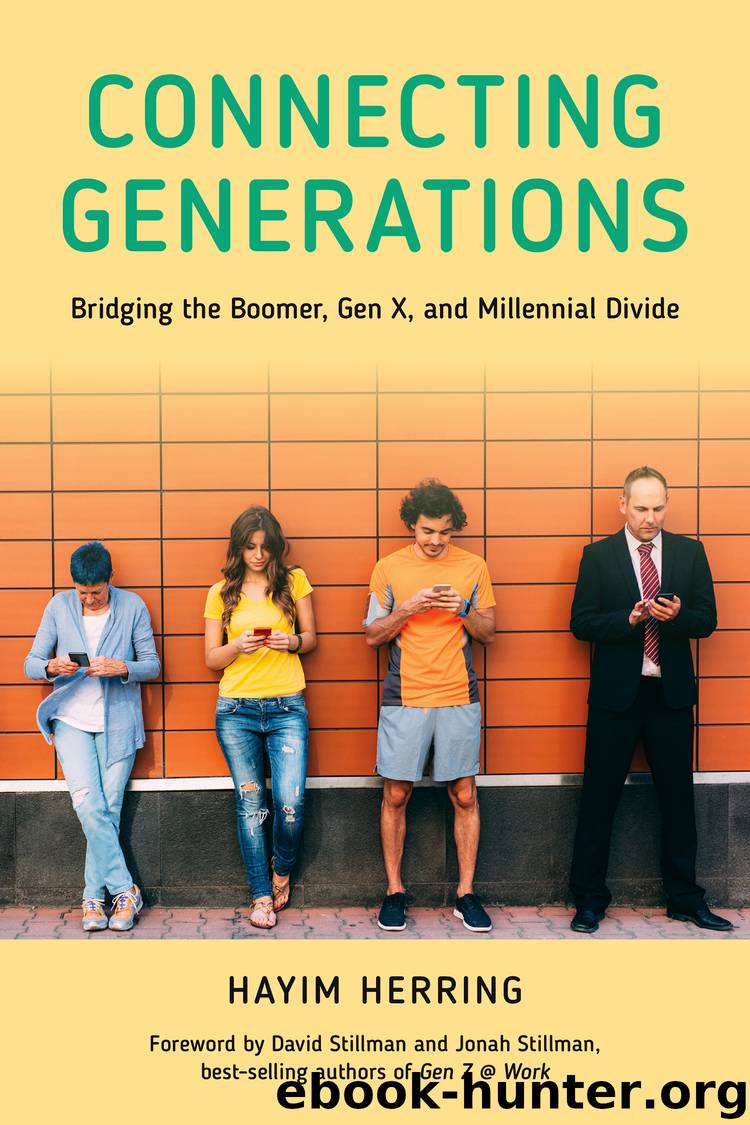Connecting Generations by Hayim Herring

Author:Hayim Herring [Herring;PhD, Hayim]
Language: eng
Format: epub
Publisher: Rowman & Littlefield Publishers
Published: 2019-02-26T16:00:00+00:00
Chapter Five
Education
Anything, Anyone, Anytime, Anywhere
The current thinking among anthropologists, historians, and evolutionary biologists is that between seventy thousand and thirty thousand years ago, “the appearance of new ways of thinking and communicating” first occurred.1 Yuval Harari, a prominent historian, refers to this as the beginning of the Cognitive Revolution.2 That’s when Homo sapiens developed “the ability to transmit information about things that do not really exist, such as tribal spirits, nations, limited liability companies and human rights.”3 Perhaps our predecessors, Neanderthals, and our earliest direct ancestors, Homo Sapiens, began to use language and symbolic thinking.4 I can almost imagine the very first conversation between an early Homo Sapien parent dramatically explaining to his child about the dangers that he encountered while traveling to a friend’s cave a half-mile away to learn a new skill or behavior. Acquiring an education was hard.
Fast forward to 2018, and if you live in a cold, snowy climate, you can still hear elderly people describe their terrifying treks through frequent blizzards to attend a school a mile or more away. We don’t have written records to verify the veracity of this imagined first Homo Sapiens’ dialogue between parent and child over the difficulties of acquiring an education, but my elderly Minnesota friends are not exaggerating because we have records of snowfall amounts when they were school-age children. As a native Boomer Philadelphian, I had it relatively easy because winters weren’t as merciless. I either carpooled or used public transportation to reach my public high school, which meant a maximum, one-way commute of about one hour. During my high school years, technology advances made learning some subject matter easier than in the past. For example, while students still had to master a mechanical slide rule for more complex mathematical calculations, we were also allowed to use handheld electronic calculators.
When I entered college in 1976, typewriters were recommended educational gear. Some of the more fortunate college students owned an IBM Selectric typewriter that replaced typing bars with golf-ball-shaped type heads with different kinds of fonts and a built-in correction key that covered errors with a white tape. (For those who are Gen X and younger, try to find an old standard typewriter if you want to appreciate the revolutionary progress that the correction key was. You could now backspace over a mistaken word or letter and correct it without having to retype an entire page, and no longer need to apply “white out” correction fluid to an error. Now that was progress!) As a college undergraduate from 1976 to 1980, some of my mysterious college friends disappeared at odd hours to use the computer lab at my college, where they learned exotic languages such as Fortran, SQL, and Cobol.
I’ve provided this very condensed, broad snapshot of education, as education required a significant amount of sacrifice until recently. You had to travel somewhere, often battling harsh weather and heavy traffic, and be physically present in a building. Educational technologies that we take for granted today (like
Download
This site does not store any files on its server. We only index and link to content provided by other sites. Please contact the content providers to delete copyright contents if any and email us, we'll remove relevant links or contents immediately.
Rewire Your Anxious Brain by Catherine M. Pittman(17598)
Talking to Strangers by Malcolm Gladwell(11901)
The Art of Thinking Clearly by Rolf Dobelli(8858)
Mindhunter: Inside the FBI's Elite Serial Crime Unit by John E. Douglas & Mark Olshaker(7844)
Becoming Supernatural by Dr. Joe Dispenza(7113)
Change Your Questions, Change Your Life by Marilee Adams(6653)
The Road Less Traveled by M. Scott Peck(6645)
Nudge - Improving Decisions about Health, Wealth, and Happiness by Thaler Sunstein(6641)
The Lost Art of Listening by Michael P. Nichols(6481)
Enlightenment Now: The Case for Reason, Science, Humanism, and Progress by Steven Pinker(6412)
Win Bigly by Scott Adams(6324)
Mastermind: How to Think Like Sherlock Holmes by Maria Konnikova(6248)
The Way of Zen by Alan W. Watts(5808)
Daring Greatly by Brene Brown(5648)
Grit by Angela Duckworth(4743)
Big Magic: Creative Living Beyond Fear by Elizabeth Gilbert(4730)
Men In Love by Nancy Friday(4337)
Flow by Mihaly Csikszentmihalyi(4058)
The Four Tendencies by Gretchen Rubin(4028)
